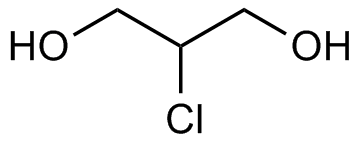2-Chloro-1,3-propanediol
| Code | Size | Price |
|---|
| CDX-C0752-M025 | 25 mg | £103.00 |
Quantity:
Prices exclude any Taxes / VAT
Overview
Regulatory Status: RUO
Shipping:
Ambient
Storage:
Short term: +4°C, Long term: -20°C
Images
Documents
Further Information
Alternate Names/Synonyms:
2-MCPD; 2-Chloro-1,3-dihydroxypropane; Glycerol beta-Chlorohydrin
Appearance:
Colourless to pale yellow liquid.
CAS:
497-04-1
EClass:
32160000
Form (Short):
liquid
GHS Symbol:
GHS06
Handling Advice:
Keep under inert gas.Very hygroscopic.
Hazards:
H301
InChi:
InChI=1S/C3H7ClO2/c4-3(1-5)2-6/h3,5-6H,1-2H2
InChiKey:
DYPJJAAKPQKWTM-UHFFFAOYSA-N
Long Description:
Chemical. CAS: 497-04-1. Formula: C3H7ClO2. MW: BD9837. 2-Chloro-1,3-propanediol (2-MCPD) is a heat-induced food contaminant present in oil- and fat-containing foodstuff. 2-MCPD is formed during the refinement of vegetable oils and fats and is therefore present in numerous oil- and fat-containing foods. This compound can be used as a reference compound for analytical studies.
MDL:
MFCD01698127
Molecular Formula:
C3H7ClO2
Molecular Weight:
110.54
Package Type:
Vial
PG:
III
Precautions:
P264 - P270 - P301 + P310 - P405 - P501
Product Description:
2-Chloro-1,3-propanediol (2-MCPD) is a heat-induced food contaminant present in oil- and fat-containing foodstuff. 2-MCPD is formed during the refinement of vegetable oils and fats and is therefore present in numerous oil- and fat-containing foods. This compound can be used as a reference compound for analytical studies.
Purity:
>98% (GC)
Signal Word:
Danger
SMILES:
OCC(Cl)CO
Solubility Chemicals:
Soluble in DMSO or methanol.
Source / Host:
Synthetic
Transportation:
Excepted Quantity
UN Nummer:
UN2810
UNSPSC Number:
12352200
Use & Stability:
Stable for at least 2 years after receipt when stored at -20°C.
References
(1) C. Crew, et al.; Food Addit. Contam. Part A Chem. Anal. Control Expo. Risk Assess. 30, 11 (2013) | (2) T. Buhrke, et al.; Food Chem. Toxicol. 106, 36 (2017) | (3) K. Schultrich, et al.; Food Chem. Toxicol. 142, 111459 (2020) | (4) A. Lampen; Process. Contam. Edible Oils 235 (2022)



